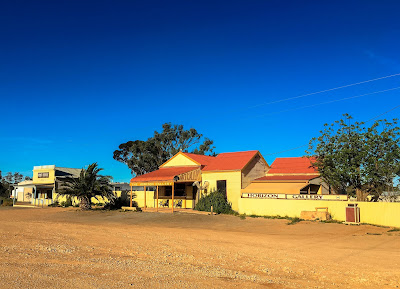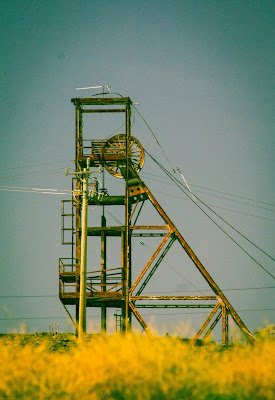Broken Hill is described as 'an isolated mining town in the far west of outback NSW'. It is variously referred to as 'The Silver City', the 'Oasis of the West' and the 'Capital of the Outback.' Just to be difficult, although it is in NSW, Broken Hill observes Australian Central Standard Time, which is the same time zone used in SA and NT. This is because at the time the Australian dominions adopted standard time, Broken Hill's only direct rail link was with Adelaide, not Sydney.
We arrived in Broken Hill quite late and under a baking sun. Our hotel was right next to the railway, which proved to be rather noisy as the mining trucks rattled along throughout the night. Trains and mining are pretty important to this town.
Broken Hill was founded as a town in 1883 by boundary rider Charles Rasp, who discovered what he thought was tin, but which were in fact silver and lead. The orebody they belonged to turned out to be the largest and richest of its kind in the world. Miners called the orebody the Line of Lode.
Like many "outback" towns, Broken Hill was built on precious metals, having once had the world's richest deposits of lead, zinc and silver.In 1933 Broken Hill, with a population of 26,925, was the third largest urban incorporated area in New South Wales. Although now depleted somewhat, mining still yields around two million tonnes annually.
Broken Hill is known for its involvement in the Labour movement of Australia and has a strong and proud history of trade unionism. In 2015 Broken Hill became the first town in Australia to be included on the National Heritage List.
 |
| Broken Hill Courthouse |
 |
| Broken Hill Post Office |
 |
| Broken Hill War Memorial |
Artworks outside the gallery are by TAFE (Technical and Further Education) students and those on the Aboriginal Arts and Crafts Education preogramme, where traditional carving techniques are taught to ensure the skills are not forgotten.
 |
| The Last Drop by TAFE Western NSW |
The Palace Hotel was built as a tea house in the 1880s by the Women's Temperance League as they were alarmed by the number of beer halls in the town. Eventually it became a pub after all and found world-wide fame when a scene from The Adventures of Priscilla, Queen of the Desert was filmed in one of the rooms.
Workers of the nearby Central Mine built a tunnel through to the hotel's basement so that they could clock on for work, tunnel off to the pub, then clock off at the end of the day and go home without anyone being any the wiser.
 |
| The Palace Hotel |
 |
| Inside the Palace Hotel |
Two-up is a particular Aussie games of chance: two coins are placed on a paddle, or 'kip' by the 'spinner' and punters bet on how they will land - two heads or two tails up. Originally brought to Australia by English and Irish convicts, the game made its way to the goldfields and further afield. It was played in the trenches and the troop ships in WWI and became synonymous with ANZAC Day, when pubs and RSL clubs across the country can legally host this usually illegal game.
Two-up has a special place in the tradition of Broken Hill, among the miners, shearers and itinerant rural workers. For most of the 20th Century the town operated an illegal two-up school, which became a tourist attraction until shut down in 1984.
However in 1992 Broken Hill City Council successfully lobbied the State Government for a permit allowing two-up to be played every day of the year. The NSW Office of Liquor, Gaming and Racing acknowledged that the game was 'an established part of the cultural heritage of this mining city'. Now, should you wish to, you can play two-up every Friday night at the Palace Hotel.
The Broken Hill Sculpture Symposium was proposed to Mayor Peter Black in April 1993 by sculptor Lawrence Beck. Beck felt that while Broken Hill was widely recognised as a centre of excellence for painting, the city was less well-known for sculpture.
Fifty-three tonnes of sandstone were moved to a reserve being developed just outside Broken Hill with a hill called Sundown as its natural focal point, and were shaped into twelve sculptures by artists from around the world. The reserve subsequently became known as the Living Desert.
Everyone says that sunset is the best time to go there, so we raced up the hill before it got dark. It's true; it's a pretty spectacular place.
Antonio Nava Tirado is an Aztec Indian who studied at the National School of Painting, Sculpture and Printing, Mexico City. His sculpture is based on the music of Jarge Reyes, Bajo El Sol Jaguar (Under the Jaguar Sun). Use of the sun and the moon depicts the duality and Night is represented by the star of Venus. The mouth of the jaguar takes the sun at night to protect it. Day is represented by the circle created by the sun.
 |
| Bajo El Sol Jaguar by Antonio Nava Tirado |
 |
| Across the Mundi Mundi Plains |
Back to the monumental mining machinery...
After more than 125 years of mining in Broken Hill, the 7.5km-long, 1.6km-deep Line of Lode has yielded 300 million tonnes of ore and generated over $100 billion. Today, mining is still the major business of the town, generating more than $400 million a year, and the two main mining operators, Perilya and CBH Resources collectively employ more than 500 locals in mining works.
The main attraction at the Albert Kersten Mining and Minerals Museum is the Silver Tree, created for the Royal Melbourne Colonial Exhibition of 1880. The hollow base is made from a single piece of metal, and is decorated with many animals and indigenous people from the area.
The little silver work used to be the centrepiece of Charles Rasp's dining table. Born Hieronymous Salvator Lopez von Pereira in Stuttgart, Charles Rasp changed his name when he emigrated to Australia in 1869. He worked a variety of jobs on rural stations including the Mount Gipps Station where he was employed as a boundary rider.
One day while mustering sheep in the Broken Hill paddock he was struck by the mineral appearance and formation of the Broken Hill. He joined forces with other local contractors, forming the Syndicate of Seven and sinking a small shaft. They were prospecting for tin, but early results showed only low grade lead ore and traces of silver. They persisted and formed the fist mining company in Broken Hill, the Broken Hill Proprietary Company Ltd (BHP).
 |
| The Silver Tree |
The Miners Memorial atop the Line of Lode commemorates the more than 800 miners who have lost their lives while at work. It is a sombre and atmospheric edifice with commanding views across the town below.
 |
| Line of Lode Miners' Memorial and restaurant |
In the late 1800s safety in the mines was the sole responsibility of the workers themselves. As a result miners put up with terrible conditions, toiling away by lamplight with hammer and chisel, and breathing silicon-laden dust and poisonous fumes. Accidents such as falling from ladders and trucks or being crushed by rockfalls and machinery were common and often resulted in death.
The plaques which line the walls of the memorial state the names of the deceased, the date they died, the manner of their death and the company for whom they worked. It's incredibly moving. As the years progress the number of deaths get fewer, but any death at work is too many.
The foreground of the memorial is artistically littered with old machinery, left to rest in the elements. Much of it looks incongruous above ground, and as the wind whips through and around it, it emits a mournful note in its unaccustomed environment.





So far on this holiday we've seen stunning coast lines, dramatic lighthouses, iconic flora and fauna, remarkable artworks, wineries, breweries, and classic outback scenery, and this is what he photographs. A lift. Sigh.
 |
| Him Outdoors is finally tempted to take a picture |









 |
| Broken Hill from above |
In 1885 Silverton had a population of 3,000. It offered a central flat position and a water supply to the many mining claims in the area. Today fewer than 40 people live here.
 |
| Silverton, NSW |
The same landscape that was once home to a legion of miners is now inspiring artists and film makers. It was the location for the film Mad Max 2, and one bloke loved the film so much that he moved from Bradford to Silverton and set up a Mad Max museum of original and replica action vehicles, props and relics that he found at the film sites.
Artists enjoy the unique land and light, which adds a harsh beauty to many works.
 |
| A VW Beetle painted by Peter Browne |
John Dynon was born in Broken Hill in 1954, left school at 14 and worked on several sheep stations in NSW and Queensland, before taking up mining back in Broken Hill. He claims it was this incredible lifestyle that kindled his passion for the changing moods of the outback. In 1985 he became a full-time artist to meet the demand that had grown for his paintings.
 |
| Silverton Artists Ute painted by Justin Cowley |
 |
| Pub Crawl by Justin Cowley |
And so we went for a walk in heat of the afternoon under the blazing sun, as we do. It was still and quiet, and we didn't see another soul - funny, that.
 |
| Into the outback, Silverton, NSW |
 |
| Mundi Mundi Plains lookout |
 |
| Horse Power |
Our final breakfast in Broken Hill - the food here is consistently good and filling, but we both felt the need of fruit for a pretence at healthy eating.
Broken Hill pioneered a culture of trade unionism, including the introduction of the 35-hour working week and the defeat of conscription in Australia. Union activities at the turn of the century were 'frequently hostile' and Broken Hill developed a reputation for intense and frequent strikes. The town remains proud of its past militancy, as depicted in murals and memorials throughout the streets.



























































































No comments:
Post a Comment